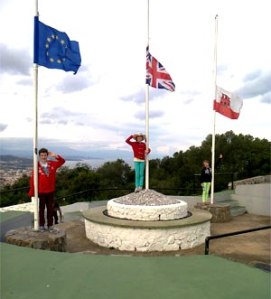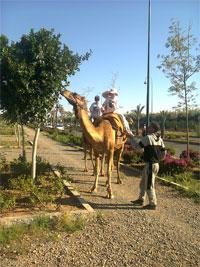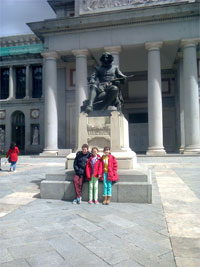Updated
Marrakech, the hard way – The Financial Times
*It’s easy to fly to Morocco. One can also get there by car, rail & sea*

Saluting Gibraltar from the Upper Rock. FT
The Financial Times, by George Parker (June 21, 2013) — There is an obvious way for those living in the UK to take a family holiday in Marrakech: drive to Gatwick, hop on an easyJet flight and a few hours later you will be drinking mint tea in the Red City. Alternatively, you could put your three children in the back of the car, catch an overnight ferry to Santander, drive across Spain, dump the car on a clifftop road overlooking the Mediterranean, transfer your stuff into rucksacks, catch a boat to Tangiers and then the night train to Marrakech. We did the latter.Accounts of this land-and-sea mission to Africa draw sharply different responses from friends: the split is roughly 50-50 between those who say “Wow” and those who conclude simply: “You must be mad”.Marrakech has always been high on my list of target holiday destinations. The Lonely Planet guide to Morocco has sat forlornly on the bookshelf for some 14 years, a reminder of a planned trip that was abruptly cancelled with news of the imminent birth of our first child.
Years of beach holidays in Devon and Normandy followed and the book gathered dust. But this year it was time for action: the kids – now 10, 12 and 13 – were ready for a “challenging” destination and they were going to do it the hard way.
It seems wrong to turn up in Marrakech with the taste of Costa Coffee from the Gatwick departure lounge still in your mouth. This, after all, is a city defined by its geography: the majesty of the Atlas mountains and the mystery of the Sahara beyond; a historic meeting place of Berbers and Moors and nomads from across the desert. Arriving on a 737 wouldn’t do it justice.
 So a plan was hatched. Marrakech would become the final destination of a trip in which the history and geography of Moorish culture would be gradually revealed, culminating in the explosion of sound and colour of the souk and kebabs in the frenetic Djemaa el Fna square. We had two weeks to get to Africa and back.
So a plan was hatched. Marrakech would become the final destination of a trip in which the history and geography of Moorish culture would be gradually revealed, culminating in the explosion of sound and colour of the souk and kebabs in the frenetic Djemaa el Fna square. We had two weeks to get to Africa and back.
No adventure is complete without overnight travel: the thrill of waking up in a different place, the weather and scenery shifting while you sleep. So the ferry from Portsmouth to the prosperous seaside town of Santander, is a good place to start.
Children’s entertainers and an onboard expert on cetaceans – the Bay of Biscay is a top whale-watching spot – keep the kids amused and by late afternoon the Picos de Europa are sliding into view and announcing the start of our Spanish road trip.
First stop, Madrid. Santander is a favoured holiday spot for Madrileños seeking respite from the summer heat and the distance between the cities can be covered in about four hours. By the time we reach Madrid at 11pm, the city is just getting going, the bars spilling out drinkers on to the streets.
We spend a couple of happy days in the city but Madrid was the creation of Felipe II – a Habsburg – whose Austrian-influenced capital was strictly outside the pedagogical remit of the grand holiday plan. To really get started, we need to head another four hours south across La Mancha to Granada and the romantic heart of Moorish culture.
Approaching Andalucia– Al-Andalus, to the Moors – across the plain one can sense the force of geography and history. The motorway heads inexorably for the wall of the Sierra Morena, described by Laurie Lee as an “east-west rampart” dividing people into different races. In his memoir As I Walked Out One Midsummer Morning he recalls: “Behind me was Old Castile and the Gothic North; beyond the Sierra the spiced blur of Andalucia.”

Riding camels
It was in Granada that the Moorish dominance of Andalucia lasted longest and found its greatest artistic expression in the Alhambra, a palace of such stunning intricacy that it is listed by the kids as near the pinnacle of their “Top 10 Holiday Memories” – just behind the time when their dad was leapt upon by a Barbary ape.The Moors held sway in southern Spain from 710 until 1492 when the Catholic monarchs completed their reconquest. After surrendering Granada, Boabdil, the last Moorish king, cried at the sight of his beloved Alhambra shimmering under the snow-capped Sierra Nevada, eliciting the immortal rebuke from his mother: “Do not weep like a woman for what you could not defend as a man.”
On a more prosaic note, those hoping to emulate Ferdinand and Isabella by entering the Alhambra should take the 21st-century precaution of booking tickets online: the number of daily visitors is strictly limited and disappointed tourists are a common feature at the gates of the complex.
Heading south, the motorway leads through the mountains to the Costa del Sol, the strip of hotels finally giving way to the first spectacular sight of the Rock of Gibraltar and then – ta ra! – the green mountains of the Rif.
At this point the trip gets a bit backpackery and – frankly – I’m a little nervous. We arrive at Tarifa (landing point for the Moorish invasion) and park the car overlooking the ferry port. Possessions are moved into rucksacks and we’re off to Africa.

Parker family at Prado in Madrid
There is a slight issue (which I thought best not to raise with Mrs P) that, unless you use an expensive third-party agency, it is impossible to book Moroccan train tickets from outside the country. We are therefore about to arrive in Tangiers – north Africa’s supposed capital of hassle – without any certain means of getting a night train out of the city.But there is some good news to report. The authorities have cottoned on to the fact that westerners have been deterred from visiting by the prospect of being mobbed by “guides” hoping to lead you to their brother’s carpet shop. A police crackdown seems to have done the trick: other travellers will undoubtedly have had different experiences, but we met very little hassle throughout our journey.
Tangiers is great: a city living through an economic boom but still possessing a shabby and seedy air, a reminder of its time as an “international zone” – a haven for dodgy money and a gay resort favoured by the likes of Kenneth and Tennessee Williams (no relation).
Meanwhile at the shiny new station there is good news for marital harmony: couchette tickets are available for the overnight Marrakech express, a service with its own sealed carriage and guard and a mixed clientele of locals and foreign visitors curious to discover what Crosby, Stills and Nash were going on about.

Alighting from a temporarily broken-down Marrakech express
The train rattles across the coastal plain and makes an unscheduled stop for several hours in the midst of a stand of cacti, but finally arrives in Marrakech just after 11am. Within minutes we are at our journey’s end – the friendly Riad Dar Dialkoum, a cool and tranquil space within the intensity of the medina – and the start of a glorious four-day stay in the city.Better to travel than to arrive? Hardly: Marrakech is never likely to disappoint the traveller with the sheer bravado with which it incorporates a medieval core into the life of a vibrant modern city. But the journey to and from the foot of the Atlas mountains is at least as memorable as the destination itself.
The return home takes in the much-maligned but fascinating colonial curio of Gibraltar, the gracious faded seaport of Cadiz, the Moorish splendour of Seville (with an obligatory night of flamenco at La Carbonería), a night in the golden university city of Salamanca and finally an afternoon on the beach in Santander whiling away the hours until the ferry sails for Portsmouth.
We arrive home in London at 10pm on Sunday night with work and school the next day. Mad? Maybe. But for the bleary-eyed occupants of the dusty car – each with a scrapbook full of memories – there is only one question: “When’s the next one?”
George Parker is the FT’s political editor
——————————————-
Details
Brittany Ferries’ Portsmouth to Santander services take 24 hours, and cost from £948 return for a car and family of four, including en suite cabin (www.brittanyferries.co.uk). FRS’s fast ferries from Tarifa to Tangiers take 35 minutes; from €66 return (www.frs.es). The Tangiers to Marrakech sleeper takes around 11 hours (for timetables see www.oncf.ma and also

Comments
[…] emulate Ferdinand and Isabella by entering the Alhambra should take the 21st-century precaution of booking tickets online: the number of daily visitors is strictly limited and disappointed tourists are a […]